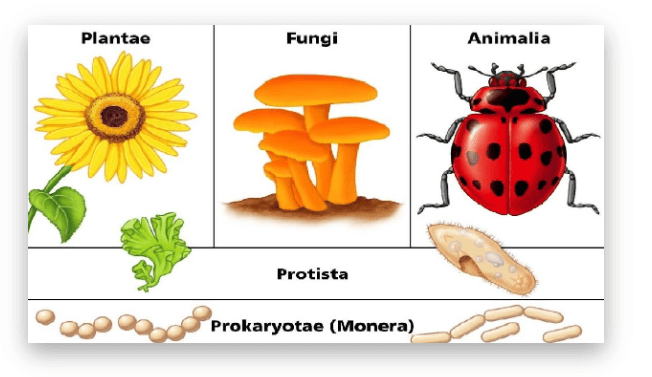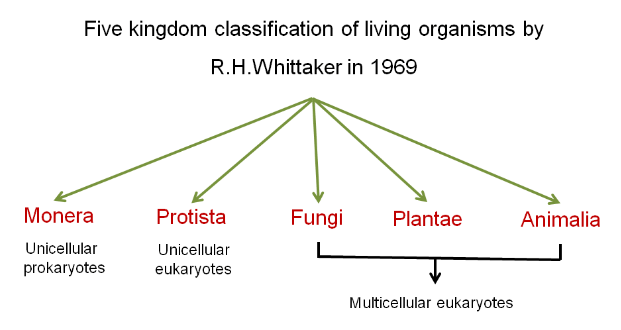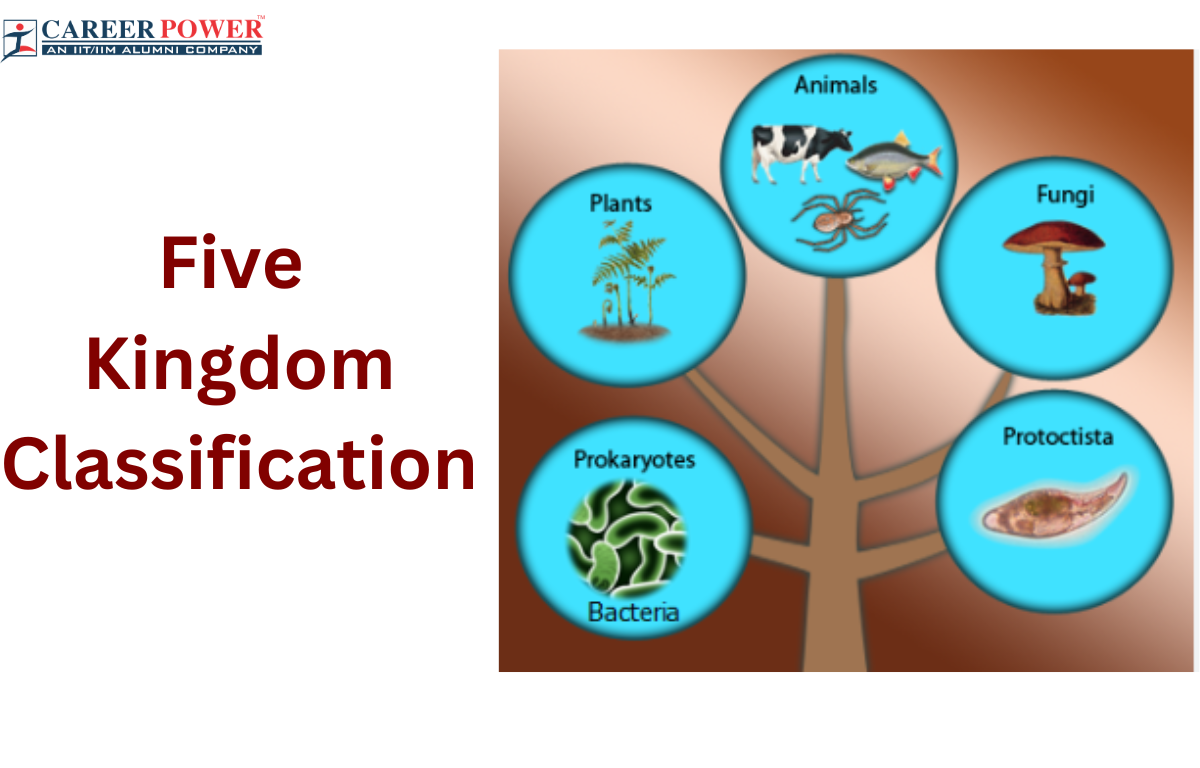The five kingdom classification is a very important topic from the chapter “Diversity in Living Organisms” in class 09th and 11th biology section. Kingdom classification is a biological system used to categorize and organize living organisms based on their shared characteristics. The highest level of classification is the kingdom, and there are five main kingdoms: Monera (Bacteria and Cyanobacteria), Protista (Unicellular Eukaryotes), Fungi (Fungi and Yeast), Plantae (Plants), and Animalia (Animals). These kingdoms are further divided into smaller groups like phyla, classes, orders, families, genera, and species. This system helps scientists understand the relationships and evolutionary history of different organisms.
Five Kingdom Classification
The five-kingdom classification is a system used to categorize living organisms into five major groups based on their characteristics and evolutionary relationships. The five kingdoms are Monera (Bacteria and Cyanobacteria), Protista (Unicellular Eukaryotes), Fungi (Fungi and Yeast), Plantae (Plants), and Animalia (Animals). This classification system was widely used, but modern advancements in genetics have led to more refined classifications.

The five-kingdom classification was proposed by biologist Robert H. Whittaker in 1969. He introduced this system as a way to categorize and classify living organisms based on their cellular structures, nutritional modes, and other fundamental characteristics. Whittaker’s classification was a significant advancement in the field of taxonomy, providing a more comprehensive framework for organizing the diversity of life.
Characteristics of Five Kingdom Classification
We have mentioned the characteristic features of the five-kingdom classification, that help us differentiate and categorize organisms into five kingdoms based on their fundamental traits and attributes. It’s important to note that the classification system has evolved, and some organisms may not fit neatly into these categories due to advancements in our understanding of their genetics and characteristics.

Animal Kingdom
The Animal kingdom includes multicellular organisms that are heterotrophic (they obtain nutrients by consuming other organisms) and lack cell walls. They exhibit a wide range of characteristics and complexities.
Features of Animal Kingdom
- The animal kingdom mainly consists of Multicellular organisms.
- The organisms that are kept in the kingdom Animalia follow Heterotrophic Nutrition.
- The animal cells do not possess any cell walls, or we can say that there is a Lack of cell walls in the kingdom Animalia.
- The organisms of the Animal kingdom Typically exhibit Mobility.
- They have a Complex Organ System.
Kingdom Plantae
Plants are multicellular, autotrophic organisms that possess cell walls made of cellulose. They are essential for producing oxygen and providing food for many organisms.
Features of Kingdom Plantae
- The kingdom Plantae mainly consists of multicellular organisms.
- The organisms that are kept in the kingdom Plantae follow Autotrophic nutrition (Photosynthesis).
- The plant cell has a cell wall which is composed of cellulose.
- The organisms of the Plantae kingdom are generally immobile.
- They possess complex reproductive structures.
Kingdom Fungi
Fungi are non-photosynthetic organisms with cell walls made of chitin. They are heterotrophic and obtain nutrients through absorption. This kingdom includes mushrooms, molds, and yeasts.
Features of Kingdom Fungi
- The kingdom fungi mostly consist of multicellular organisms and some unicellular organisms like yeasts.
- The organisms that are kept in the kingdom of fungi follow heterotrophic nutrition by the process of absorption.
- Their cell wall is composed of Chitin.
- The fungi reproduce both by sexual and asexual modes of reproduction.
- There is a lack of mobility in the kingdom of fungi.
Kingdom Protista
This diverse kingdom consists of mostly unicellular eukaryotes. They don’t fit into the other kingdoms neatly and include various forms, from photosynthesis with the help of photosynthetic algae to amoebas.
Features of Kingdom Protista
- Kingdom Protista are mostly unicellular organisms, but some of them are multicellular.
- They possess Eukaryotic cells.
- Protista has different modes of nutrition such as photosynthesis, ingestion, and absorption.
- They lack specialized tissues and organs.
- They can be found in many different forms and may have different functions.
Kingdom Monera
Kingdom Monera includes prokaryotic organisms (these organisms lack a true nucleus) like bacteria. They are unicellular and lack membrane-bound organelles. The Monerans are further classified into Archaebacteria, Eubacteria, and Cyanobacteria
| Differnt types of Monerans | |
| Types | Description |
| Archaebacteria | Archaebacteria are tiny living things that can survive in very harsh places, like hot springs or salty lakes. They are one of the oldest life forms on Earth and are different from regular bacteria. |
| Eubacteria | Eubacteria are common bacteria found everywhere, like in soil, water, and even inside our bodies. Some are helpful, like those in our stomachs, while others can cause diseases. |
| Cyanobacteria | Cyanobacteria, also called blue-green algae, are bacteria that can make their own food using sunlight. They are found in water and are important because they produce oxygen, helping life on Earth. |
Features of Kingdom Monera
- Monera are mostly unicellular organisms.
- They have a prokaryotic cell which lacks a true nucleus.
- Monera does not consist of any membrane-bound organelles.
- They have a vast variety of habitats and metabolic processes.
- The organisms placed in the kingdom monera reproduce through binary fission.
Advantages of the Five Kingdom Classification
The five-kingdom classification proposed by Robert H. Whittaker has several advantages. However, it’s important to note that as scientific understanding has progressed, some limitations and challenges of this classification have been identified, leading to the development of alternative classification systems that reflect more recent insights into genetic relationships among organisms.
- Comprehensive Representation: The system recognizes a wide range of organisms and provides a more inclusive classification that accommodates various forms of life.
- Reflects Evolutionary Relationships: The classification reflects evolutionary relationships by grouping organisms based on their fundamental characteristics and shared ancestry.
- Clearer Characteristics: It offers a clearer separation between prokaryotes (Monera) and eukaryotes (the other four kingdoms), highlighting a fundamental distinction in cellular structure.
- Acknowledges Microorganisms: By including separate kingdoms for bacteria and protists, the system acknowledges the significance and diversity of microorganisms.
- Teaching and Learning Tool: The system is often used as an educational tool to introduce students to the diversity of life in a structured manner.
- Historical Significance: Whittaker’s five kingdom classification was an important step in the development of modern taxonomy, paving the way for subsequent refinements and advancements in our understanding of life’s diversity.



 50 Vegetables Name for Kids in English a...
50 Vegetables Name for Kids in English a...
 Food Chain: Definition, Types, Examples,...
Food Chain: Definition, Types, Examples,...
 Human Respiratory System: Definition, Di...
Human Respiratory System: Definition, Di...













